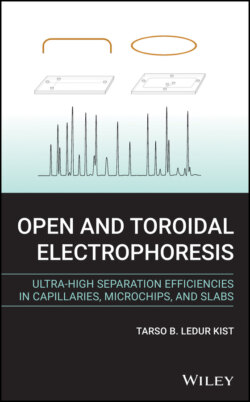Читать книгу Open and Toroidal Electrophoresis - Tarso B. Ledur Kist - Страница 25
1.2 Binary Mixtures and Other Solvents
ОглавлениеBesides pure water, some binary mixtures of water and a protogenic organic polar solvent (methanol, ethanol or 2-propanol) or a protophilic organic polar solvent (acetonitrile, acetone or dimethylsulfoxide) have been studied and applied as solvents in ESTs [14,15], over the years. For instance, water-methanol, [16] water-ethanol, [17] water-isopropanol, [18] and water-acetonitrile. [19] For some applications they are necessary for many reasons. Firstly, to improve the solubility of analytes that exhibit poor solubility in pure water. Secondly, to control the electroosmotic flow in order to shorten or extend the run time. Apparent mobility (from injection point to detection point) can be increased for analytes that are easily separated, shortening the run time. This decreases the distance run by the analytes in the reference frame of the liquid phase, providing the benefit of a shorter run time but consequently decreasing the separation efficiency. Many mixtures are difficult to separate and in this case the electroosmotic flow is set to run in the opposite direction to the analytes. This means that the analytes now run longer distances in the reference frame of the liquid, which means that the separation efficiency is tremendously increased. However, as discussed in many Sections (e.g. 2.9 and 2.10), electroosmosis is difficult to control and exhibits poor repeatability from run to run. This has a negative impact on peak identification and quantitative analyses. Third, a number of other minor benefits occur depending on the amount of organic modifier present; these benefits include: many binary mixtures exhibit a much longer shelf life (microbial growth is inhibited); some can be stored at 8 C without freezing, so that they reach working temperature much quicker than frozen solutions; standard solutions of biomolecules last much longer in these mixtures; and the dynamic viscosity of the mixture can be increased/decreased, which is beneficial when working with micro-channels and capillaries with a broad range of diameters.
Finally, there are a few applications (for instance the separation of aminium ions, quaternary ammonium ions, and coordination complexes) that can be run with pure propylene carbonate, formamide or other solvents, since the analytes remain charged within them. Moreover, propylene carbonate, for instance, does not produce gases at the electrodes, allowing the separation to be run in sealed systems.
